国际商法
国际商法与法学的区别

国际商法与法学的区别
国际商法(International Business Law)和法学(Jurisprudence)是两个不同的学科领域,主要区别包括以下几个方面:
1. 研究对象:国际商法主要研究国际商务活动中涉及的法律规范和法律关系,涉及国际贸易、国际投资、跨国公司等商业领域的法律问题;而法学研究的对象相对广泛,包括了法律的本质、法律制度、法律哲学等方面。
2. 视角不同:国际商法更侧重于商业和经济领域的法律问题,研究重点在于商业交易中的合同、国际贸易纠纷解决、知识产权保护等;而法学更侧重于法律的基本原理、法律体系、法律的社会功能等方面。
3. 国际性:国际商法主要研究跨国交易和国际法律体系,因此更注重涉及不同国家和地区之间的法律规范和争端解决机制;而法学更偏向于各国法律制度的研究和国内法律问题。
4. 专业性:国际商法是一门应用性较强的学科,它旨在培养具有实际操作能力的法律专业人才,需要掌握商业法律知识和业务技巧;而法学作为一门学科,更关注法律理论的研究和法律教育。
总的来说,国际商法是法学的一个分支,其研究对象和视角都更专注于商业领域的法律问题,而法学则更广泛地涵盖了法律的各个方面。
国际商法概述
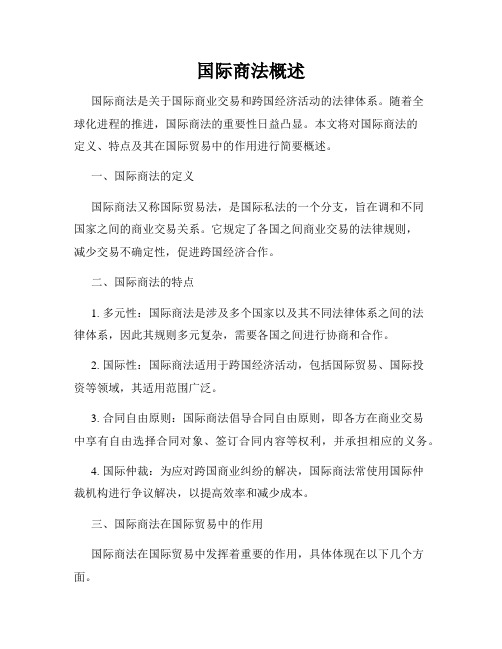
国际商法概述国际商法是关于国际商业交易和跨国经济活动的法律体系。
随着全球化进程的推进,国际商法的重要性日益凸显。
本文将对国际商法的定义、特点及其在国际贸易中的作用进行简要概述。
一、国际商法的定义国际商法又称国际贸易法,是国际私法的一个分支,旨在调和不同国家之间的商业交易关系。
它规定了各国之间商业交易的法律规则,减少交易不确定性,促进跨国经济合作。
二、国际商法的特点1. 多元性:国际商法是涉及多个国家以及其不同法律体系之间的法律体系,因此其规则多元复杂,需要各国之间进行协商和合作。
2. 国际性:国际商法适用于跨国经济活动,包括国际贸易、国际投资等领域,其适用范围广泛。
3. 合同自由原则:国际商法倡导合同自由原则,即各方在商业交易中享有自由选择合同对象、签订合同内容等权利,并承担相应的义务。
4. 国际仲裁:为应对跨国商业纠纷的解决,国际商法常使用国际仲裁机构进行争议解决,以提高效率和减少成本。
三、国际商法在国际贸易中的作用国际商法在国际贸易中发挥着重要的作用,具体体现在以下几个方面。
1. 规范经济活动:国际商法通过立法、公约等形式规范各国之间的经济活动,为商业交易提供法律依据和保障,促进跨国经济合作发展。
2. 降低交易成本:国际商法通过制定统一的法律规则和商事仲裁机制,降低跨国交易中存在的不确定性和风险,减少纠纷的发生,从而降低交易成本。
3. 促进国际贸易自由化:国际商法推崇合同自由原则,为各国之间的商业交易提供了自主选择合同内容和合同对象的权利,促进国际贸易的自由化。
4. 维护合同权益:国际商法为各方在商业交易中的权益提供了法律保护,当合同发生违约或争议时,可以依据国际商法进行维权,维护合同权益。
5. 促进国际经济合作: 国际商法的制定和实施,有助于不同国家之间加强经济联系和合作,促进国际贸易的繁荣与发展。
四、国际商法的挑战与展望随着全球经济格局的不断变化和技术的快速发展,国际商法面临着一些挑战。
国际商法详解课件

国际商法与国内商法的关系
总结词
国际商法与国内商法的联系和区别
详细描述
国际商法和国内商法在国际商业交易中共同发挥作用,但它们的来源、适用范围和管辖权等方面存在明显的区别。 国际商法主要来源于国际条约、国际惯例和国际商业实践,而国内商法则是由各国的立法机构制定。国际商法的 适用范围更广泛,管辖跨国商业交易,而国内商法则主要适用于本国范围内的商业活动。
主要贸易术语
包括FOB、CIF、CFR、DPU、DDP等,每个术语都有明确的责任和风险划分,有助于买 卖双方明确各自的权利和义务。
术语适用范围
国际贸易术语解释通则适用于国际货物买卖合同,但不适用于个人消费品或初级产品。
国际货物买卖合同公约
国际货物买卖合同公约概述
国际货物买卖合同公约是关于国际货物买卖合同的国际法律标准, 旨在统一和规范国际货物买卖合同的法律适用。
当事人不履行或者不适当履行合同义 务的,即为违约。
在某些情况下,违约责任可以免除, 例如不可抗力等。
违约责任的承担方式
当事人一方不履行合同义务或者履行 合同义务不符合约定的,应当承担继 续履行、采取补救措施或者赔偿损失 等违约责任。
国际商事合同的解除
解除的条件 当事人协商一致或者符合法定解除条件的,可以解除合同。
调解
通过第三方调解机构或调解员 协助双方当事人达成和解协议。
仲裁
双方当事人自愿将争议提交仲 裁机构,通过仲裁裁决解决争
议。
诉讼
双方当事人将争议提交法院, 通过法院判决解决争议。
国际商事仲裁制度
仲裁协议
双方当事人在争议发生前或发 生后达成书面仲裁协议,同意
将争议提交仲裁解决。
仲裁机构
双方当事人可以选择国际仲裁 机构或国内仲裁机构进行仲裁。
国际商法名词解释

国际商法名词解释国际商法:是指调整国际商事交易和商事组织的各种关系的法律规范的总称。
国际商法的渊源:主要是指国际商法产生的依据和表现形式,主要有三个,一是国际条约,二是国际贸易惯例,三是各国有关商事和国际贸易的国内法。
国际贸易惯例:国际贸易惯例是在长期的国际贸易实践中逐渐形成的,并被相关各方所普遍承认和遵守的一种行为规范。
大陆法系:是指以罗马法为基础而形成和发展起来的一个完整的法律体系的总称。
主要代表国家是法国和德国。
普通法系:是指以英国中世纪以来的法律,特别是它的以普通法为基础的发展起来的一种法律制度。
法典:是把有关同一类内容的各种法规和原则收集起来,加以系统化,汇编为一个单一的法律文件。
衡平法:为了补充和匡正普通法的不足而产生的,当时由国王指示枢密大臣在处理案件时可不受普通法的约束,而按照“公平与正义”的原则作出判决,这些判决就形成了衡平法。
《法律重述》:美国法学会把同经济活动有密切联系的商法和部分民法的判例法进行综合审理,编纂成各种判例法汇编法律:由全国人大及常委会制定的,主要规定和调整国家社会生活某一方面问题的法律文件。
法律从属于宪法,其效力仅次于宪法。
司法解释:是指对于法院审判的工作和检察院工作中具体应用法律的问题,分别由最高人民法院和最高人民检察院进行解释,这些解释对其下级法院和检察院的审判和检查工作具有约束力。
合同:是指当事人之间设立、变更、终止民事关系的协议。
依法成立的合同,受法律保护。
合同法:是调整合同关系的法律规范的总称。
根本违反合同:是指如果一方当事人违反合同的结果,使另一方当事人蒙受损害,以致于实际上剥夺了他根据合同有权期待得到的东西。
预期违反合同:在合同规定的履行期到来之前,已有根据预示合同的另一方当事人显然将不履行其大部分重要合同义务,即为预期违反合同。
其救济方法是中止履行合同。
对价:指合同一方的得到的某种权利、利益、利润或好处,或是他方当事人克制自己不行使某项权利或遭受某项损失或承担某项义务。
国际商法知识点范围
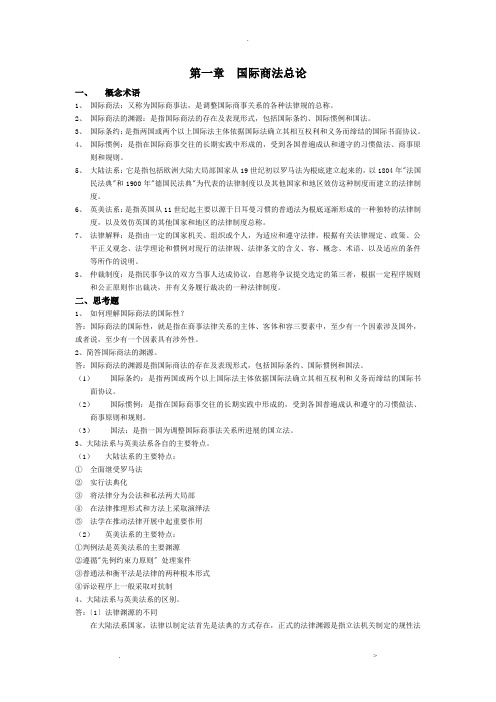
第一章国际商法总论一、概念术语1、国际商法:又称为国际商事法,是调整国际商事关系的各种法律规的总称。
2、国际商法的渊源:是指国际商法的存在及表现形式,包括国际条约、国际惯例和国法。
3、国际条约:是指两国或两个以上国际法主体依据国际法确立其相互权利和义务而缔结的国际书面协议。
4、国际惯例:是指在国际商事交往的长期实践中形成的,受到各国普遍成认和遵守的习惯做法、商事原则和规则。
5、大陆法系:它是指包括欧洲大陆大局部国家从19世纪初以罗马法为根底建立起来的,以1804年"法国民法典"和1900年"德国民法典"为代表的法律制度以及其他国家和地区效仿这种制度而建立的法律制度。
6、英美法系:是指英国从11世纪起主要以源于日耳曼习惯的普通法为根底逐渐形成的一种独特的法律制度,以及效仿英国的其他国家和地区的法律制度总称。
7、法律解释:是指由一定的国家机关、组织或个人,为适应和遵守法律,根据有关法律规定、政策、公平正义观念、法学理论和惯例对现行的法律规、法律条文的含义、容、概念、术语、以及适应的条件等所作的说明。
8、仲裁制度:是指民事争议的双方当事人达成协议,自愿将争议提交选定的第三者,根据一定程序规则和公正原则作出裁决,并有义务履行裁决的一种法律制度。
二、思考题1、如何理解国际商法的国际性?答:国际商法的国际性,就是指在商事法律关系的主体、客体和容三要素中,至少有一个因素涉及国外,或者说,至少有一个因素具有涉外性。
2、简答国际商法的渊源。
答:国际商法的渊源是指国际商法的存在及表现形式,包括国际条约、国际惯例和国法。
(1)国际条约:是指两国或两个以上国际法主体依据国际法确立其相互权利和义务而缔结的国际书面协议。
(2)国际惯例:是指在国际商事交往的长期实践中形成的,受到各国普遍成认和遵守的习惯做法、商事原则和规则。
(3)国法:是指一国为调整国际商事法关系所进展的国立法。
3、大陆法系与英美法系各自的主要特点。
国际商法课件
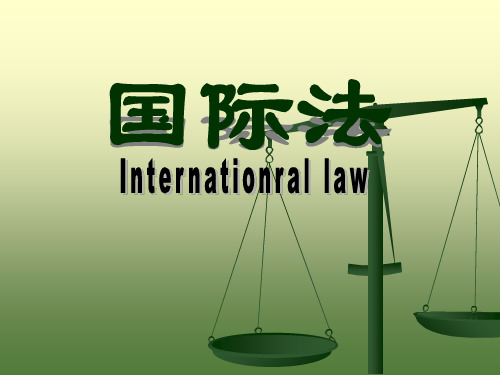
2020/12/13
国际法
15
大陆法系各国的法院组织
大陆法各国的法院组织虽然各有特点,但都 有一些共同之处.主要表现在: 法院的层次基本相同;各国除普通法院以外, 都有一些专门法院与普通法院同时并存. 各国法院基本上都分为三级,即第一审法院、 上诉法院和最高法院.
2020/12/13
国际法
16
普通法系的概念和特征
2020/12/13
国际法
24
2.反共,也可以说是冷战意识
在美国,反共产党、反共产主义和社会主 义,是不需要任何理由的,反本身就是理 由。马克思主义归根到底就是一句话:反 对资本奴役劳动,最终要消灭资本,解放 劳动,未来要让劳动者自由联合,自己为 自己劳动。所以,共产党传承马克思,美 国则是最崇拜资本、最强大的资本主义国 家,谁有资本、谁的资本大,谁就有权利, 谁可以说了算,没有资本就没有发言权。
2020/12/13
国际法
19
"先例约束力的原则"
1)上议院的判决是具有约束力的先例,对全国各级审判机关 都有约束力, 一切审判机关都必须遵循,但上议院可不受其先例的约束. (2)上诉法院的判决可构成对下级法院有约束力的先例,而 且对上诉法院本
身也有约束力. (3)高级法院的每一个庭的判决对一切低级法院有约束力, 对高等法院的其
2020/12/13
国际法
7
国际条约的种类
条约又分双边条约和多边条பைடு நூலகம்(又称公约)
2020/12/13
国际法
8
(二)国际惯例
国际惯例,是指国际经济法主体重复类似的行为而上升为 对其具有拘束力的规范. 法律上的惯例与习惯是有本质的不同的,前者一旦被当事 人加以采用,便对该当事人具有法律拘束力,后者只是一种 习惯的行为.从这个意义上说,虽然国际惯例没有普遍的约 束力,无法与国际公约的效力相比,但在某些具体的当事人 之间却有像国际公约一样的强制力.有些国际惯例已经被 某些国家纳入其国内的成文法,从而具有了法律的普遍约 束力.还有些国家的国内法规定,国际惯例的适用无须当事 人明示表示同意.由此可见,目前国际惯例与国际公约在强 制力上的这种区别已经被渐渐淡化了,采用国际惯例已经 成为国际上的一种趋势.我国对国际商事活动中的国际惯 例,历来给予高度的重视,并严格予以遵守.
第1章 国际商法概述 《国际商法》PPT课件

在现代大陆法系国家的商法中, 最具有代表性、影响力最大的是 法国和德国的商事法。1807年的 《法国商法典》和1900年的《德 国商法典》曾是许多大陆法系国 家仿效的对象,大陆法系亦是以 此为基础建立起来的。
• (1)法国商事法。 • (2)德国商事法。
1.3 西方两大商法体系
1.3.3 英美法系中的商法体系
英美法系国家以英国和美国为代表,尽管两国在法律渊源等方面有许多近似之处,但在自身
的发展过程中也形成了各自独特的体系,商法体系也不例外。
1)英国商事法 英国是传统的判例法国家,没有像大陆法那种形式意义上的商法,但在英国存在实质上的商法。可以毫不夸张 地说,大陆法系现代商法中的各项基本制度在英国法中均有类同的法律概括,这不仅表现在有关公司法、票据 法、保险法、破产法等特别法中,而且表现在对商人资格、商业组织、商事合伙、商事代理等一系列的基本规 定和定义概括中。 英国的商人法像大陆法系一样,也起源于中世纪的商人习惯法。
1.2.1 国际条约
国际条约或公约是国际商法的最 主要渊源,是国际法主体之间以 国际法为准则,为确立其相互权 利、义务而缔结的书面协议。
1.2.3 国内商事法
国际商法的主体主要是各国的自然人和法 人,国家只有在特殊情况下才会成为国际 商法的主体,这个特点决定了各国的国内 商事法也是国际商事行为的法律依据。
1.3 西方两大商法体系
1.3.2 大陆法系中的商法体系
1)民商合一与民商分立
2)各国的商事法
在对待商法的态度上,大陆法系 国家有两种做法:有些大陆法系 国家把民法和商法分别编成独立 的法典,即民法典和商法典。
• (1)民商合一。 • (2)民商分立。 • (3)民法与商法的适用原则。 • (4)我国民法与商法的关系。
《国际商法教案》课件
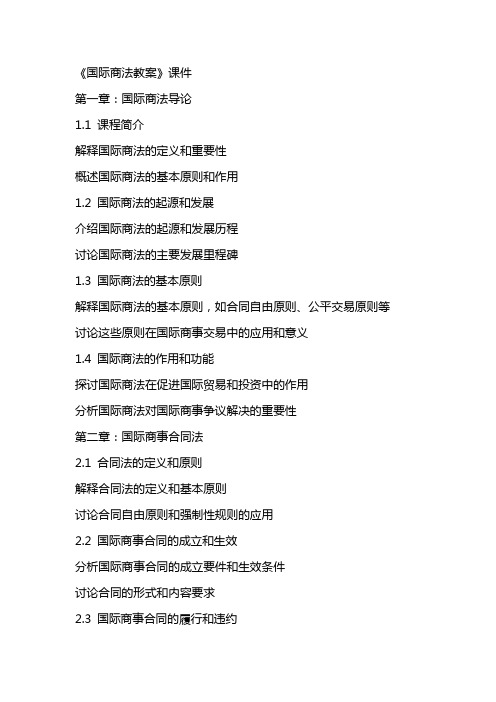
《国际商法教案》课件第一章:国际商法导论1.1 课程简介解释国际商法的定义和重要性概述国际商法的基本原则和作用1.2 国际商法的起源和发展介绍国际商法的起源和发展历程讨论国际商法的主要发展里程碑1.3 国际商法的基本原则解释国际商法的基本原则,如合同自由原则、公平交易原则等讨论这些原则在国际商事交易中的应用和意义1.4 国际商法的作用和功能探讨国际商法在促进国际贸易和投资中的作用分析国际商法对国际商事争议解决的重要性第二章:国际商事合同法2.1 合同法的定义和原则解释合同法的定义和基本原则讨论合同自由原则和强制性规则的应用2.2 国际商事合同的成立和生效分析国际商事合同的成立要件和生效条件讨论合同的形式和内容要求2.3 国际商事合同的履行和违约解释合同的履行原则和方式讨论违约的认定和违约责任的处理2.4 国际商事合同的终止和解除探讨合同终止和解除的原因和效果讨论合同终止后的权利和义务处理第三章:国际贸易术语3.1 国际贸易术语的定义和作用解释国际贸易术语的重要性概述国际贸易术语的演变和发展3.2 国际贸易术语的主要条款介绍国际贸易术语的主要条款,如FOB、CIF、DDP等分析这些条款的含义和应用3.3 国际贸易术语的解释和适用讨论国际贸易术语的解释规则和适用原则分析不同国际贸易术语在不同交易中的应用和选择3.4 国际贸易术语的风险转移和责任分配解释国际贸易术语中风险转移和责任分配的规则讨论这些规则对国际商事交易的影响和意义第四章:国际货物运输法4.1 货物运输法的定义和原则解释货物运输法的定义和基本原则讨论货物运输合同的法律适用和管辖权4.2 国际海上货物运输合同分析国际海上货物运输合同的法律规定讨论海运合同中承运人的责任和义务4.3 国际空运货物运输合同介绍国际空运货物运输合同的法律规定分析空运合同中承运人的责任和义务4.4 国际多式联运合同解释国际多式联运合同的定义和特点讨论多式联运合同中的责任分配和风险转移第五章:国际商事争议解决5.1 争议解决方式的概述介绍国际商事争议解决的常见方式,如协商、调解、仲裁和诉讼讨论各种争议解决方式的优缺点和适用情况5.2 国际商事仲裁解释国际商事仲裁的定义和特点分析仲裁协议的成立和仲裁程序的进行5.3 国际商事仲裁裁决的承认和执行讨论国际商事仲裁裁决的承认和执行规则分析不同国家和地区对仲裁裁决的承认和执行情况5.4 国际商事诉讼介绍国际商事诉讼的基本原则和程序讨论国际商事诉讼中的管辖权和法律适用问题《国际商法教案》课件第六章:国际知识产权法6.1 知识产权法的定义和国际保护解释知识产权法的定义和重要性讨论知识产权在国际商事交易中的保护6.2 国际商标法分析国际商标法的原则和规定讨论商标的国际注册和保护6.3 国际专利法介绍国际专利法的原则和规定分析专利的国际申请和保护6.4 国际版权法解释国际版权法的原则和规定讨论版权的国际保护和国际版权组织第七章:国际支付法7.1 支付法的定义和原则解释国际支付法的定义和基本原则讨论支付方式的选择和支付义务的履行7.2 国际汇付法分析国际汇付的法律规定和支付程序讨论汇付方式的特点和应用7.3 国际托收法介绍国际托收的法律规定和托收程序分析托收方式的优势和风险7.4 国际信用证法解释国际信用证的定义和作用讨论信用证的法律规定和信用证的履行第八章:国际商事税收法8.1 税收法的定义和国际税收原则解释税收法的定义和国际税收原则讨论税收管辖权和税收协定的意义8.2 国际货物贸易的税收问题分析国际货物贸易中的关税和增值税问题讨论国际贸易税收筹划的方法和原则8.3 国际服务贸易的税收问题介绍国际服务贸易中的税收问题和税收规定分析服务贸易税收筹划的策略和限制8.4 国际投资和转移定价问题解释国际投资中的转移定价问题讨论转移定价的税收筹划和国际税收监管第九章:国际商事保险法9.1 保险法的定义和原则解释保险法的定义和基本原则讨论保险合同的成立和保险责任的承担9.2 国际海上保险法分析国际海上保险法的特点和规定讨论海上保险合同的条款和保险赔偿的计算9.3 国际货物运输保险法介绍国际货物运输保险法的法律规定分析货物运输保险合同的条款和保险赔偿的范围9.4 国际商事责任保险法解释国际商事责任保险的定义和作用讨论责任保险合同的条款和保险赔偿的计算第十章:国际商事伦理法10.1 商事伦理法的定义和重要性解释国际商事伦理法的定义和重要性讨论商事伦理在国际商事交易中的作用10.2 国际商事伦理规范分析国际商事伦理规范的主要内容和原则讨论商事伦理规范在国际商事交易中的应用和遵守10.3 国际商事社会责任介绍国际商事社会责任的概念和原则分析商事社会责任在国际商事交易中的实践和影响10.4 国际商事伦理监管和法律框架解释国际商事伦理监管和法律框架的建立和实施讨论国际商事伦理监管的挑战和未来发展《国际商法教案》课件第十一章:国际银行法11.1 银行法的定义和原则解释国际银行法的定义和基本原则讨论银行合同的成立和银行责任的承担11.2 国际银行业务的法律规定分析国际银行业务的法律规定,如贷款、信用证、保理等讨论这些业务的法律要求和风险管理11.3 国际银行监管法介绍国际银行监管法的法律规定和监管机构分析银行监管的主要内容和监管措施11.4 国际银行合规和法律风险管理解释国际银行合规的重要性讨论银行合规和反洗钱法律风险管理的策略和程序第十二章:国际金融法12.1 金融法的定义和国际金融市场解释国际金融法的定义和国际金融市场的基本概念讨论国际金融市场的主要参与者和发展趋势12.2 国际货币法分析国际货币法的原则和规定讨论货币政策和外汇管制的法律问题12.3 国际证券法介绍国际证券法的基本原则和法律规定分析证券发行和交易的法律要求和监管框架12.4 国际金融衍生品法解释国际金融衍生品法的定义和特点讨论金融衍生品合同的法律规定和风险管理第十三章:国际商事知识产权法13.1 知识产权法的定义和国际保护解释知识产权法的定义和重要性讨论知识产权在国际商事交易中的保护13.2 国际商标法分析国际商标法的原则和规定讨论商标的国际注册和保护13.3 国际专利法介绍国际专利法的原则和规定分析专利的国际申请和保护13.4 国际版权法解释国际版权法的原则和规定讨论版权的国际保护和国际版权组织第十四章:国际商事信息技术法14.1 信息技术法的定义和原则解释国际商事信息技术法的定义和重要性讨论信息技术合同的成立和履行14.2 国际电子商务法分析国际电子商务法的基本原则和法律规定讨论电子商务合同的法律适用和电子签名的重要性14.3 国际数据保护法介绍国际数据保护法的基本原则和法律规定分析数据保护的法律要求和个人信息保护的实践14.4 国际网络法解释国际网络法的基本概念和法律规定讨论网络空间的治理和网络安全法律风险管理第十五章:国际商事法务管理15.1 法务管理的定义和重要性解释国际商事法务管理的定义和重要性讨论法务管理在国际商事企业中的作用15.2 国际商事法律风险管理分析国际商事法律风险的种类和识别讨论法律风险管理的策略和程序15.3 国际商事法律合规解释国际商事法律合规的重要性讨论企业合规政策和程序的建立和实施15.4 国际商事法律争议解决介绍国际商事法律争议解决的方式和程序分析争议解决策略和谈判、调解、仲裁和诉讼的选择重点和难点解析本文主要介绍了《国际商法教案》课件的十五个章节内容,涵盖了国际商法导论、合同法、贸易术语、货物运输法、商事争议解决、知识产权法、支付法、税收法、保险法、商事伦理法、银行法、国际金融法、商事知识产权法、信息技术法、商事法务管理等多个领域。
国际商法( 国际贸易法)
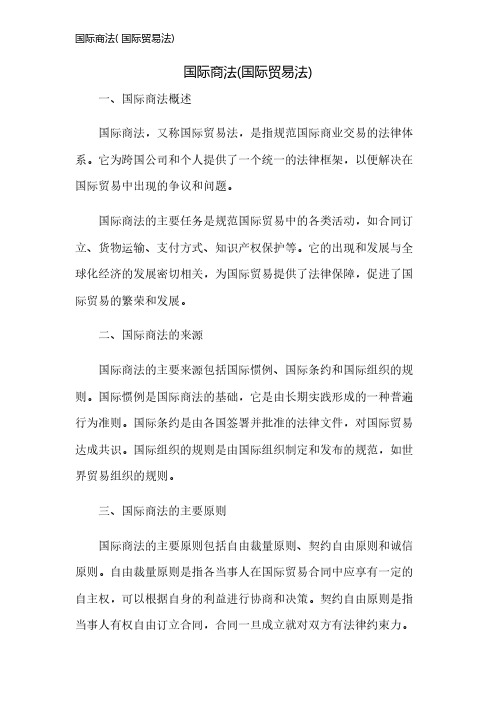
国际商法(国际贸易法)一、国际商法概述国际商法,又称国际贸易法,是指规范国际商业交易的法律体系。
它为跨国公司和个人提供了一个统一的法律框架,以便解决在国际贸易中出现的争议和问题。
国际商法的主要任务是规范国际贸易中的各类活动,如合同订立、货物运输、支付方式、知识产权保护等。
它的出现和发展与全球化经济的发展密切相关,为国际贸易提供了法律保障,促进了国际贸易的繁荣和发展。
二、国际商法的来源国际商法的主要来源包括国际惯例、国际条约和国际组织的规则。
国际惯例是国际商法的基础,它是由长期实践形成的一种普遍行为准则。
国际条约是由各国签署并批准的法律文件,对国际贸易达成共识。
国际组织的规则是由国际组织制定和发布的规范,如世界贸易组织的规则。
三、国际商法的主要原则国际商法的主要原则包括自由裁量原则、契约自由原则和诚信原则。
自由裁量原则是指各当事人在国际贸易合同中应享有一定的自主权,可以根据自身的利益进行协商和决策。
契约自由原则是指当事人有权自由订立合同,合同一旦成立就对双方有法律约束力。
诚信原则是指各方在国际贸易中应本着诚实守信的原则进行交易,不得采取欺诈行为。
四、国际商法的典型案例国际商法有很多典型案例,如《国际货物销售合同》、《国际货物运输合同》、《国际支付方式》等。
在这些典型案例中,各方需遵守合同约定和国际贸易规则,以确保交易的顺利进行和合法权益的保护。
五、国际商法的挑战与发展随着全球化经济的深入发展,国际商法面临着一系列的挑战和机遇。
一方面,技术的进步和贸易方式的变革给国际商法带来了新的问题,如电子商务、知识产权保护等;另一方面,国际商法的发展为解决这些问题提供了法律依据和解决方案,如国际商事仲裁制度、国际仲裁法等。
六、国际商法作为规范国际贸易的法律体系,对于促进国际贸易的繁荣和发展起到了重要的作用。
它为跨国公司和个人提供了法律保障,解决了在国际贸易中出现的争议和问题。
随着全球化经济的不断发展,国际商法面临新的挑战和机遇,需要不断完善和进步,以适应全球经济的发展需求。
国际商法 名词解释

1.International commerce law:国际商法,是指调整国际商事主体和国际商事行为的俄各种法律规范的总称.它强调的是各国商人之间从事跨国境的商业活动,尤其是跨国间贸易和投资活动方面的法律规范.mon law :普通法, 在不同时期的判例的基础上发展起来、具备司法连贯性特征并在一定的司法共同体内普遍适用的各种原则、规则的总称3.Equity :衡平法, 是英国自14世纪末开始与普通法平行发展的、适用于民事案件的一种法律4.大陆法系;一般是指以罗马法为基础而形成和发展起来的一个完整的法律体系总称5.英美法系:是指英国中世纪以来的法律,是以普通法为基础的,与以罗马法为基础的民法法系相比较而存在的一种法律制度.实体法是指规定具体权利义务内容或者法律保护的具体情况的法律,如民法、合同法、婚姻法、公司法等等。
程序法是规定以保证权利和职权得以实现或行使,义务和责任得以履行的有关程序为主要内容的法律,如行政诉讼法、行政程序法、民事诉讼法、刑事诉讼法、立法程序法等等。
国际贸易法:国际之间的贸易关系以及与贸易有关的其他各种关系的法律规则。
(商事交易)国际商法:调整国际商事组织(公司、投资)与商事交易(买卖)的各种法规的总称。
强调各国商人(企业)之间从事商业活动,尤其是贸易和投资活动方面的法律规范。
英美法系:中世纪以来英国的法律以及受其影响或仿其模式制定的美国及其他国家法律的总称。
以普通法为基础的一中法律指读。
大陆法系:以罗马法为基础而形成和发展起来的一个完整的法律体系的总称。
独资企业(个人企业):由一个出资者单独出资,并以自己的财产、对企业债务承担无限责任的经营实体。
特点:企业非法人,无独立财产合伙企业:由两个或者两个以上的合伙人通过订立协议,约定共同出自、合伙经营、共享收益、共担风险,并对合伙企业债务承担无限连带责任的盈利性组织。
特点:企业非法人,无限责任。
合作企业:由法定人数以上的社员出资组成的,在互助的基础上,以共同经营的方式谋求社员经济利益或提供生产和生活服务的社团法人。
《国际商法》教学大纲(两篇)
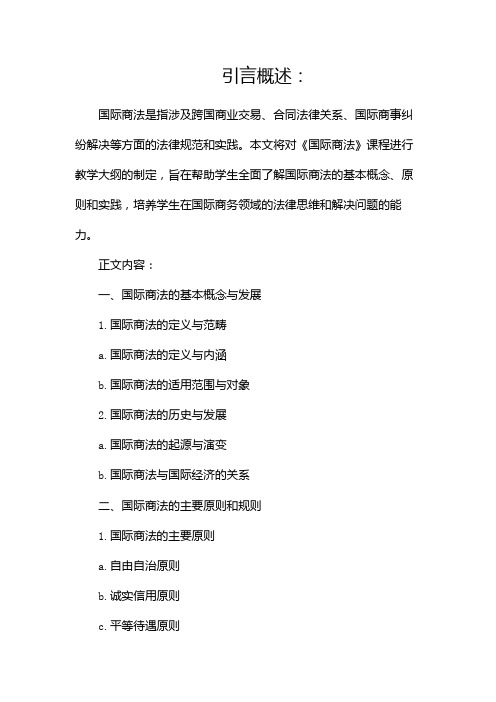
引言概述:国际商法是指涉及跨国商业交易、合同法律关系、国际商事纠纷解决等方面的法律规范和实践。
本文将对《国际商法》课程进行教学大纲的制定,旨在帮助学生全面了解国际商法的基本概念、原则和实践,培养学生在国际商务领域的法律思维和解决问题的能力。
正文内容:一、国际商法的基本概念与发展1.国际商法的定义与范畴a.国际商法的定义与内涵b.国际商法的适用范围与对象2.国际商法的历史与发展a.国际商法的起源与演变b.国际商法与国际经济的关系二、国际商法的主要原则和规则1.国际商法的主要原则a.自由自治原则b.诚实信用原则c.平等待遇原则2.国际商法的主要规则a.合同的形成与效力规则b.合同的履行与违约规则c.法律制裁与争议解决规则三、国际商事合同的要素和特点1.国际商事合同的要素a.合同的当事人及其主体资格要求b.合同的客体与内容要求c.合同的形式与效力要求2.国际商事合同的特点a.合同的国际性与跨境性特点b.合同的灵活性与多样性特点c.合同的风险与监管特点四、国际商事争议解决机制与实践1.国际商事争议解决机制a.仲裁制度与实践b.诉讼制度与实践c.调解与争议解决规则2.国际商事争议解决实践案例分析a.仲裁案例分析b.诉讼案例分析c.调解案例分析五、国际商法的发展与前景展望1.国际商法的发展趋势a.国际商法与国际贸易的发展趋势b.国际商法与国际投资的发展趋势2.国际商法的前景展望a.国际商法应对全球化挑战的策略b.国际商法在区域经济一体化中的作用结论:通过本课程的学习,学生将全面了解国际商法的基本概念、原则和实践,培养国际商务领域的法律思维和解决问题的能力。
同时,本课程还将使学生对国际商法发展趋势与前景有更为清晰的认识,并为他们未来从事跨国商务和法律实践提供坚实的理论基础和实践指导。
国际商法教学大纲引言:国际商法作为商业领域中的一个重要分支,是指在国际商业交易中适用的法律原则和规则。
随着全球化的发展,国际商务合作愈发频繁,对于了解和应用国际商法的需求也与日俱增。
国际商法

客观必须的代理权需要具备三个条件: (1)行使这种代理权是实际上或商业上所必需的; (2)代理人在行使这种权利前无法与委托人取得 联系得到委托人的明示 ; (3)代理人所采取的措施必须是善意的并且必须 考虑到所有有关当事人的利益。
公约法律将违约分为根本违反合同和非根本违反合同两种。
根本违约
如果一方出现根本违约,则另 一方不但可以要求损害赔偿, 而且有权利撤销合同。
违约
非根本违约
如果一方的违约行为是非根本违 约,则另一方只可以要求损害赔 偿,但是不可以撤销合同。
关于过错责任原则:
大陆法中有过错责任原则,即只有违约方在履 行合同的过程中存在过错,才需要承担违约责任。 但是联合国国际货物买卖合同公约没有采取过 错责任原则,也就是说,违反合同的一方,不需 要需证明违约方存在过错,就可以要求损害赔偿 或者让违约方承担其他违约责任。
(二)大陆法
(三)国际商事合同通则以及联合国国际货物买卖合同公 约
(四)中国法
(一)英美法 合同自由是美国法的基本原则,合同一般采用不要式 原则,既可以采用口头形式,也可以采用书面形式。
美国《防止欺诈法》规定,以下合同必须采用书面形 式: 1.不能在一年内履行的合同 2.买卖土地以及有关土地权益的合同 3.允诺为他人偿还债务(担保合同) 《统一商法典》规定: 价金在500美元以上的货物买卖合同必须采用书面形式
(二)英美法 1.从代理权产生方式划分 (1)明示的授权 本人以清楚明白的语言或文字 明确的指定某人为他的代理人。
国际商法课件

当事人与国际组织之间的法律关系
1 2 3
国际组织的职能与作用
国际组织在国际商事活动中发挥着重要作用,如 制定国际商事规则、促进国际贸易、推动国际合 作等。
当事人与国际组织的合作
当事人可以通过参与国际组织的活动,加强与其 他国家和地区的交流与合作,共同推动国际商事 活动的繁荣与发展。
国际组织对当事人的支持与帮助
跨国公司的法律组织形式
跨国公司可以根据不同国家的法律规定,采取不同的法律组织形 式,如子公司、分公司、代表处等。
跨国公司的治理结构
跨国公司的治理结构应符合各国的法律规定,同时应考虑公司内部 的组织架构、管理流程等因素。
跨国公司的合同管理
跨国公司在进行业务活动时,需要与各国的供应商、客户等主体签 订合同,应遵守各国的合同管理规定。
例子
如各国的公司法、合同法 、知识产权法等。
判例和学说
定义
判例是法院在审判过程中作出的 具有法律效力的判决或裁定;学 说则是学者对法律问题的研究和
观点。
作用
判例和学说在国际商法的实践中 具有重要的参考价值,它们可以 作为解释法律和解决争议的依据
。
例子
如国际商事仲裁中的案例和学者 对于国际商法问题的研究著作等
商事争议解决法律制度
争议解决方式
规定解决商事争议的方 式,如协商、调解、仲 裁、诉讼等。
仲裁制度
详细阐述仲裁制度的特 点、适用范围、仲裁程 序等。
诉讼制度
详细阐述诉讼制度的特 点、适用范围、诉讼程 序等。同时,还应当包 括对国际商事仲裁裁决 的承认和执行的规定。
06
国际商法的实践应用
跨国公司的经营管理
裁、诉讼等方式。
国际投资的风险与防范
什么是国际商法
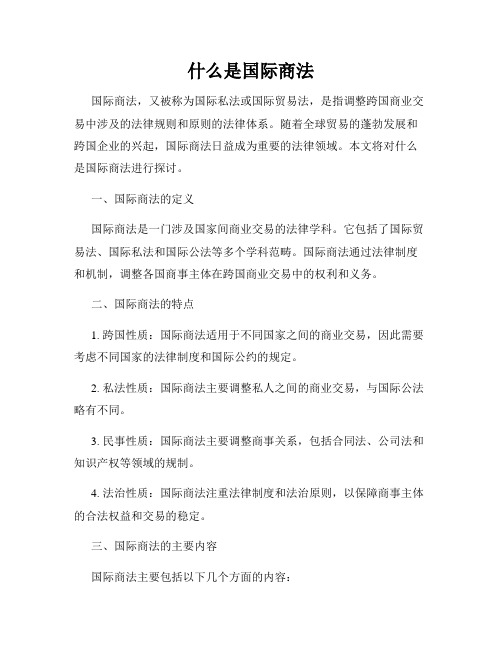
什么是国际商法国际商法,又被称为国际私法或国际贸易法,是指调整跨国商业交易中涉及的法律规则和原则的法律体系。
随着全球贸易的蓬勃发展和跨国企业的兴起,国际商法日益成为重要的法律领域。
本文将对什么是国际商法进行探讨。
一、国际商法的定义国际商法是一门涉及国家间商业交易的法律学科。
它包括了国际贸易法、国际私法和国际公法等多个学科范畴。
国际商法通过法律制度和机制,调整各国商事主体在跨国商业交易中的权利和义务。
二、国际商法的特点1. 跨国性质:国际商法适用于不同国家之间的商业交易,因此需要考虑不同国家的法律制度和国际公约的规定。
2. 私法性质:国际商法主要调整私人之间的商业交易,与国际公法略有不同。
3. 民事性质:国际商法主要调整商事关系,包括合同法、公司法和知识产权等领域的规制。
4. 法治性质:国际商法注重法律制度和法治原则,以保障商事主体的合法权益和交易的稳定。
三、国际商法的主要内容国际商法主要包括以下几个方面的内容:1. 跨国贸易规则:国际商法通过调整贸易合同、国际货物销售和运输等规则,保障跨国商业交易的顺利进行。
2. 跨国投资规则:国际商法通过调整外国投资、跨国并购和知识产权保护等规则,鼓励和规范跨国投资行为。
3. 跨国争端解决:国际商法通过建立仲裁机构和争端解决机制,解决跨国商事纠纷,保障商事主体的权益。
4. 国际商法片面性:国际商法还包括了一些专门领域的规则,如国际金融法、国际货币法和国际电子商务法等。
四、国际商法的意义国际商法在全球经济一体化的背景下具有重要的意义:1. 促进国际贸易:国际商法为跨国商业交易提供了清晰的法律规则和机制,降低了跨国交易的风险和成本,促进了国际贸易的发展。
2. 保护商事主体权益:国际商法通过保护商事主体的合法权益,提升了商事主体的信心和合作意愿。
3. 维护经济秩序:国际商法通过规范跨国商业交易行为,维护了公平竞争的市场环境和经济秩序。
4. 解决商事纠纷:国际商法建立了跨国商事纠纷解决机制,提供了高效的纠纷解决方式,保障了商事主体的权益。
国际商法
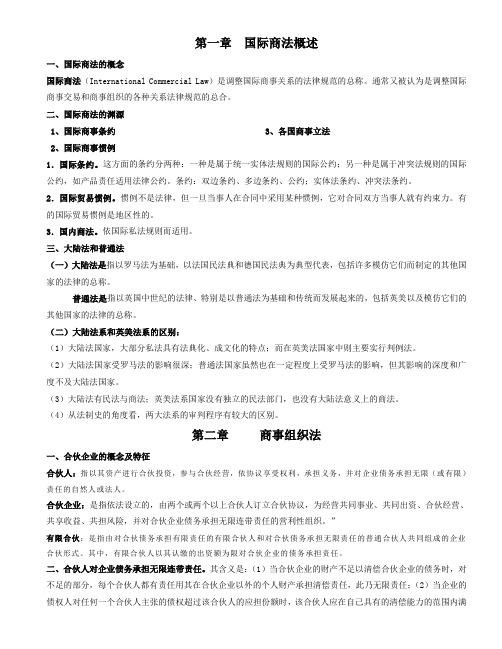
第一章国际商法概述一、国际商法的概念国际商法(International Commercial Law)是调整国际商事关系的法律规范的总称。
通常又被认为是调整国际商事交易和商事组织的各种关系法律规范的总合。
二、国际商法的渊源3、各国商事立法1、国际商事条约2、国际商事惯例1.国际条约。
这方面的条约分两种:一种是属于统一实体法规则的国际公约;另一种是属于冲突法规则的国际公约,如产品责任适用法律公约。
条约:双边条约、多边条约、公约;实体法条约、冲突法条约。
2.国际贸易惯例。
惯例不是法律,但一旦当事人在合同中采用某种惯例,它对合同双方当事人就有约束力。
有的国际贸易惯例是地区性的。
3.国内商法。
依国际私法规则而适用。
三、大陆法和普通法(一)大陆法是指以罗马法为基础,以法国民法典和德国民法典为典型代表,包括许多模仿它们而制定的其他国家的法律的总称。
普通法是指以英国中世纪的法律、特别是以普通法为基础和传统而发展起来的,包括英美以及模仿它们的其他国家的法律的总称。
(二)大陆法系和英美法系的区别:(1)大陆法国家,大部分私法具有法典化、成文化的特点;而在英美法国家中则主要实行判例法。
(2)大陆法国家受罗马法的影响很深;普通法国家虽然也在一定程度上受罗马法的影响,但其影响的深度和广度不及大陆法国家。
(3)大陆法有民法与商法;英美法系国家没有独立的民法部门,也没有大陆法意义上的商法。
(4)从法制史的角度看,两大法系的审判程序有较大的区别。
第二章商事组织法一、合伙企业的概念及特征合伙人:指以其资产进行合伙投资,参与合伙经营,依协议享受权利,承担义务,并对企业债务承担无限(或有限)责任的自然人或法人。
合伙企业:是指依法设立的,由两个或两个以上合伙人订立合伙协议,为经营共同事业、共同出资、合伙经营、共享收益、共担风险,并对合伙企业债务承担无限连带责任的营利性组织。
”有限合伙:是指由对合伙债务承担有限责任的有限合伙人和对合伙债务承担无限责任的普通合伙人共同组成的企业合伙形式。
法律知识:国际商法的基本原则和规则

法律知识:国际商法的基本原则和规则国际商法是指各国之间在商业交易中所遵循的法律规则和原则。
国际商法的基本原则和规则在国际贸易中起着非常重要的作用,它们为商业活动提供了法律保障,并且帮助各国在商业交易中解决争议。
本文将系统地介绍国际商法的基本原则和规则。
一、国际商法的基本原则1.自由原则自由原则是国际商法的核心原则之一。
它包括自由竞争原则、自由贸易原则和自由合同原则。
自由原则主张市场自由化和贸易自由化,主张各国之间在商业交易中不设国界限制。
自由原则的基础是各国都有权自主制定贸易政策和签订贸易协议,不能接受他国的干涉。
在国际贸易中,自由原则是各国商业活动可以自由进行的法律基础。
2.信赖原则信赖原则是指在商业活动中,各方应当按照诚实信用的原则进行交易,互相遵守合同和承诺。
根据信赖原则,商业合同应当是双方自愿达成的,各方应当按照合同约定履行自己的责任。
信赖原则不仅适用于合同关系,也适用于商业交易中的其他法律关系,如债权债务关系和担保关系等。
3.平等原则平等原则是指在商业交易中,各方是平等的主体,应当在平等地位上行使各自的权利和承担各自的义务。
平等原则要求各方在商业活动中相互尊重对方的权利,不得强迫对方做出违背其意愿的行为。
平等原则还要求合同是平等自愿订立的,不得有一方占据强势地位对另一方进行不公平对待。
4.诚实守信原则诚实守信原则是指各方在商业活动中应当诚实守信,不得进行欺骗和虚假宣传。
在商业合同中,各方应当诚实履行合同义务,不得通过欺诈手段来获得不当利益。
诚实守信原则也是商业信誉的基础,它要求各方在商业活动中应当维护自己的商业信誉,不得损害其他商业主体的商业信誉。
5.公平原则公平原则是指在商业活动中,各方应当遵循公平竞争的原则,不得采取不正当手段来破坏市场秩序。
公平原则要求各方在商业交易中应当尊重市场规则,不得通过垄断、价格欺诈、不正当限制竞争、胁迫等手段来干扰市场秩序。
二、国际商法的基本规则1.合同规则合同规则是国际商法的核心规则之一。
国际商法( 国际贸易法)

国际商法( 国际贸易法)国际商法(国际贸易法)什么是国际商法?国际商法,也称为国际贸易法,是指涉及跨国经济交易和商业活动的法律规范。
它主要是研究和规范国际商业合作、跨国投资、国际贸易和相关争议解决的法律原则和规则。
国际商法的基本原则国际商法有几个基本原则:1. 合同自由原则:各方在平等自愿的基础上自由订立合同,享有自主选择合作对象、合同内容和条款的权利。
2. 诚信原则:合同各方应以诚实守信的态度履行合同义务,维护合同关系的稳定和可靠性。
3. 平等原则:国际商法倡导各方在商业活动中平等相待,尊重各方的权益和合法利益。
4. 公正原则:国际商法追求公正,保障各方在合同履行和争议解决中的公正权益。
5. 国家主权原则:国家拥有自主决定和管理本国经济活动的权力,但也要尊重国际法和国际经济组织的规定。
国际商法的主要内容国际商法的主要内容包括:1. 国际贸易规则:涉及国际货物贸易、服务贸易、知识产权、国际运输和支付等方面的规则。
2. 国际投资规则:规定了跨国投资的条件、限制和保护措施,以及对外商投资的准入规则。
3. 国际商事争议解决:包括国际商事仲裁、国际商业调解和跨境诉讼等方式解决商事争议。
国际商法的重要组织和法律文书国际商法的重要组织包括:1. 联合国国际贸易法委员会(UNCITRAL):负责制定和推广国际贸易法规则的机构。
2. 世界贸易组织(WTO):负责协调和解决全球贸易相关的争端和问题。
3. 国际商会(ICC):提供商业行为准则、争议解决服务和国际商事标准的非政府组织。
国际商法的重要法律文书包括:1. 联合国国际货物销售合同公约(CISG):规范跨国货物销售合同的国际公约。
2. 统一的国际商事仲裁法(UNCITRAL仲裁规则):用于国际商事仲裁的规则。
3. 国际商会国际商事调解规则(ICC调解规则):用于国际商事调解的规则。
以上是关于国际商法(国际贸易法)的基本概述,它在促进全球贸易和经济合作中起着重要的作用。
- 1、下载文档前请自行甄别文档内容的完整性,平台不提供额外的编辑、内容补充、找答案等附加服务。
- 2、"仅部分预览"的文档,不可在线预览部分如存在完整性等问题,可反馈申请退款(可完整预览的文档不适用该条件!)。
- 3、如文档侵犯您的权益,请联系客服反馈,我们会尽快为您处理(人工客服工作时间:9:00-18:30)。
Teaching Program for International Business Law(国际商法教学大纲)Shandong UniversitySchool of Law, Institute of International Law姜作利教授博士Prof. & Dr. Jiang ZuoliTel: 86333313For the Whole CourseObjectives1.To provide an introduction of various theories of international business lawand explore their claims in terms of being descriptive (claiming to tell us how the law is), explanatory (claiming to tell us why the law as it is), prescriptive (claiming to tell us how the law should be), predictive (claiming to tell us how the law would be) and constitutive (claiming to tell us how the theory shapes the way the law is)2.To provide a critical overview of some of the major issues and concepts ofinternational business law3.To give students the opportunity to develop a more critical awareness of theintricacy of law and the international legal systems4.To help students develop skills of doing international businessBasic ContentsI.Introduction to International Business LawII.Forms of International BusinessIII.Legal System of International BusinessIV.Contract Law for International Sale of GoodsV.Finance of International TradeVI.The Law of AgencyVII.International commercial Dispute settlementImportant and Difficult PointsI.Sources of International Business LawII.International Organizationsparison of Municipal Legal SystemsIV.Some Important Trade TheoriesV.UN Convention on Contract for the International Sale of Goods(CISG)VI.UNIDROIT Principles of International Commercial Contracts(PICC)VII.International Rules for the Interpretation of Trade Terms(Incoterms 2000)VIII.Validity and Formation of International Sale of ContractsIX.Battles of FormsX.Remedies for Breach of ContractsXI.Anticipatory Breach of ContractXII.Passing of RiskXIII.Excuses for Non-performanceXIV.Bill of ExchangeXV.Collection of Documentary Bills through BanksXVI.Important Principles of Letters of CreditXVII.Fraud Exception in Letter of CreditXVIII.Duties of Agent and PrincipalXIX.Termination of an AgencyXX.Jurisdiction and Venue for Settlement of International Commercial DisputesXXI.Alternative Dispute ResolutionXXII.The Application of Procedure Law and Substantive Law XXIII.Arbitration AgreementXXIV.Recognition and Enforcement of AwardsChapter One Introduction to International BusinessLawObjectives1.To provide a general and brief survey of history and sources ofinternational business law2.To give a general introduction to the more important internationalorganizations3.To make a comparison of municipal legal systemsBasic contents1.The concept of international business law2.The history of international business law3.The sources of international business law4.International Organizations5.The Roman-Germanic Civil Law System and theAnglo-American Common Law SystemImportant and Difficult Legal Concepts and Issues1.International business law is originated in commercial practicesof European merchants known as international trade usages andpractices2.Merchant law3.National law is also a source of international business law4.The Roman-Germanic Civil Law System and theAnglo-American Common Law System are developeddifficultly but are coming more and more close in recentdecadesI.What is International Business LawInternational business law is the body of rules and norms that regulates activities carried out outside the legal boundaries of states. In particular, it regulates the business transactions of private persons internationally, and the international relationships of international commercial organizations.In comparison with the traditional international business law, contemporary international business law covers much more extensively, such as law for the international trading of goods, company law, negotiable instrument law, maritime law, insurance law, law of international technology transfer, industrial property law, international investment law, international financial law, international tax law, law of international dispute settlement.II.Merchant lawEuropean merchants have developed many practices and usages, and the courts worked out practical and fair rules and procedures based on the merchants‟ customs. Soon these same rules were being applied both in governmental and church courts, and eventually the lex mercatoria(商人习惯法)became an international body of generally accepted commercial rules that transcended national boundaries. It also proved to be more influential than even the civil law, spreading to England where the Roman law tradition was resisted by the local legal community. Today, many of the concepts contained in the law merchant are incorporated in modern commercial law codes, such as the United Nations Convention on Contracts for the International Sale of Goods.III.International model lawInternational model law means the rules and norms worked out and passed by some international organizations for the free choice by individual nations. International model law is not international treaties or conventions and is of no certain legal validity, however, it incorporates many general principles of law from various legal systems and also most well-known customs and usages in international business practices. Therefore, many countries like to use it as a means of interpreting international business customs, and as model for their national legislature. So, international model law is an important source for international business law.IV.International trade customs and usagesInternational trade customs and usages mean the general rules and practices in international trade activities that have become generally adopted through unvarying habit and common use. “The existence and scope of a usage of trade are to be determined as questions of fact. If a usage is embodied in a written trade code or similar writing the interpretation of the writing is to be determined by the court as a question of law. Unless otherwise agreed, a usage of trade in the vocation or trade in which the parties are engaged or a usage of trade of which they know or have reason to know gives meaning to or supplements or qualities to their agreement .”V.Civil Law and Common Law SystemsHistorically, the civil law dates to 450 B.C, the traditional date when Rome adopted its Twelve Tables. The most significant historical event in the development of the civil law, however, was the compilation and codification of all Roman law done under the direction of Byzantine Emperor Justinian (A.D. 483-565). This code, known as the Corpus Juris Civilis, was compiled between A.D. 528 and 534. It was important because it preserved the ancient legal system in written forms. The Roman law was displaced to some extent by the rules of the Germanic tribes when they overran the Western Empire. Germanic tribal law, however, recognized the principle of personal (as opposed to territorial) law, so the former Roman subjects and their descendants were allowed to follow the Roman law. The medieval Roman Catholic Church also played an important role in preserving the ancient law because its Canon law, the law used in church courts, was based on Roman law.With the revival of interest in classical culture in Western Europe in the eleventh and twelfth centuries, accompanied by the discovery of a copy of the long lost Corpus Juris Civilis(国法大全), active study of the ancient Roman law began in earnest. At universities in northernItaly—especially Bologna—the Corpus Juris Civilis was systematically analyzed, first by glossators (who added notes—annotations—explaining its meaning) and later by commentators (who attempted to adapt it to the needs of their time). Students from throughout Europe, who traveled to Italy to study, returned to their own countries to start the new profession of lawyers. They not only set up new universities in Paris, Oxford, Prague, Heidelburg, Cracow, and Coperhagen, but also found work both in the Church and as advisors to princes and municipalities. Their common background led to the creation of a new civil law, one based on the Roman law, canon law, and the huge body of writings created by the glossators and commentators. This was called the jus commune, or the common law of Europe.The origins of the Anglo-American Common Law System can be traced back to the year 1066,when the Normans conquered England and William the Conqueror began to centralize his new kingdom‟s governmental administration. The name “common law” is derived from the theory that the king‟s courts represented the common custom of the realm, as opposed to the local customary law practiced in the county and manorial courts.Development of the enduring principles of the common law was largely the product of three courts created by Henry II (1133-1189). The Court of Exchequer settled tax disputes; the Court of Common Pleas dealt with matters that did not involve the king‟s direct interest, such as title to land, enforcement of promises, and payment of debts; and the Court of King‟s Bench handled cases of a direct royal interest, such as the issuance of “writs” (written decrees) to control unruly public officials. Eventually, the jurisdiction of the King‟s Bench was used to control abuses of power by the king himself, establishing a fundamental doctrine of the common law: the supremacy of the law. Also, when the Court of Common Pleas began to charge large fees to hear cases, much of its jurisdiction was taken over by the King‟s Bench. The judges of the King‟s Bench did this by broadly interpreting the writ of trespass so that it took in virtually every kink of tort, and by expanding the meaning of the writ of assumpsit so that it applied to most forms of contracts.Review questions:1. What is meant by the term …International Model Law‟? Briefly list three of its main features.2. Explain international treaties, using two examples.3. Outline three circumstances in which international trade customs and usages are effective to the parties to a contract.4. Compare and contrast the Roman-Germanic Civil Law System and the Anglo-American Common Law System.5. Briefly describe how and why China came to accept international business law.6. The CISG contains no provisions that a contract for the sale of goods be supported by consideration. Further, the CISG does not address questions related to the validity of the contract, including legality, mistake, fraud, duress, or undue influence. How will national courts handle these issues in cases that they might be called upon to decide under the CISG? In common law countries? In civil law countries? How has this been addressed by courts in China?Chapter Two Forms of International BusinessObjectivesTo provide a general survey of important trade theories for the students to help to obtain a better understanding of international business law considering the fact that international business law is devoted to the regulation of international business activities.Basic Contents1.Some important trade theories: specialization, absolute advantage, comparative advantage, opportunity cost2.A brief introduction to some terms such as tariffs, nontariff barriers, export restrictions, and international licensing agreementImportant and difficult concepts and legal issuesspecialization, absolute advantage, comparative advantage, opportunity costI. SpecializationWhy nations trade? Economists in western countries believe that the reason is that all nations benefit from specialization(专业化). All nations have particular talents and resources; like individuals, whole nations are able to specialize in one or many activities. For example, the islands of the Caribbean have abundant sunshine and good weather year round, and so the islands specialize in tourism. Specialization here means that each nation should specialize by applying the law of comparative advantages to its resource endowment. It enables nations to emphasize the activities at which they are most efficient and at the same time gain certain advantages through trade. Nation A will specialize in X, if that is where its comparative advantage lies, and produce all X demanded by itself and Nation B. It will obtain from B since B produces enough for both. If costs rise as outputs increase, specialization will not be complete; trade will be carried to the point where costs are equalized in the countries.II. Absolute AdvantageAdam Smith said trade between nations would increase real wealth via the division of labor. He assumed an absolute advantage (绝对优势)necessary, in that an exporting industry must beable to produce, with given inputs, a larger output than any rival. Assume that two nations use the same composite input mix of land, labor, and capital with the result that nation A produces twice as much of two commodities as nation B. Nation A has absolute advantage with respect to both commodities; therefore, B cannot produce for export trade.III. Comparative AdvantageAbsolute advantage explains that trade between two countries will likely emerge because each can specialize at what it does best—emphasizing the production at which it is most efficient—and with the other country for its requirements the other goods. So, both countries will be better off because specialization and trade lead to increases in production and there to increases in the attainable consumption levels of both goods in both countries. However, this trade theory does not explain why a country with the ability to produce two or more goods but at higher input cost trade with other countries with the same ability. That‟s to say, neither countries have absolute advantage in production of any goods.Comparative advantage (比较优势)means that countries will specialize in producing several products and services in which they have lower opportunity costs than their trading partners. For example, a hilly, rocky country will not be able to raise as many sheep per acre as a country with fertile grasslands, but the rocky land cannot support any production other than sheep raising, whereas the grassland will support more lucrative cattle production. Even though the grassland is absolutely more efficient at producing both sheep and cattle, the rocky land has a comparative advantage in sheep growing because the opportunities forgone are nearly worthless. The rocky country will therefore tend to specialize in sheep, the grassy country in cattle.It is clear that comparative advantage explain that even a country that does not have any absolute advantage in producing several goods, can benefit from trading with other countries.IV. Opportunity CostOpportunity cost theory (机会成本理论)is one of the most important theories in international trade and the well-known concept of sustainable development of world economy. Opportunity cost means the value of the benefit that is given up to produce one economic good as opposed to another.The concept of opportunity cost is crucial to all economic activities, because all resources are limited. Steel used to product girders cannot be used to produce locomotives; labor services used to product shoes cannot be used to build houses. Therefore, in order to ascertain the cost of choosing one alternative use of a given set of limited resources rather than another, the economist uses the opportunity cost concept. He measures the “real” cost of doing business by its opportunity cost, not by its explicit, or outlay, cost. The real cost of producing nails, for example, is the value of another product, say rails, that might have been produced from the same amount or resources.In utilizing the opportunity cost concept, however, it is not sufficient simply to compare the values of different products that can be produced by utilizing a given set of resources in more or less the same manner. To illustrate, assume that a man has a farm and has invested his life savings in land and equipment, with all of which he grows alfalfa. The opportunity cost of such economicactivity might be the difference between the value of alfalfa and the value of some other crop that he could also produce. He could have put his self-owned, self-employed resources to entirely different uses, however. By using his resources as he has, he has forgone the opportunities of (1) lending his savings and receiving interest on that investment, (2) renting his land and receiving income therefrom, (3) working for someone else for wages. If the total return from such alternative uses of his resources were greater than the return from the production of any other crop that he might grow, it is that return that is the measure of the opportunity cost to him of growing alfalfa.From the point of view of economics, the most rational use of resources is that use which produces the greatest return. Although opportunity cost is the true measure of the cost of one use of a given set of resources as compared with any other use, the most rational use is that which produces the greatest return. Therefore, the economically relevant opportunity cost of a given activity is the difference between the values of the benefit that would have been produced by the most rational alternative use of the resources concerned.VI. Tariffs and Nontariff Barriers to TradeTariffs are taxes placed on imports either by value (ad valorem duty) (从价税)or per unit of quantity (specific duty)(从量税). They are imposed for many reasons, including (1) the collection of revenue, (2) the protection of domestic industries from foreign competition, and (3) political control (e.g., to provide incentives to import products from politically friendly countries and to discourage importing products from unfriendly countries.)Nontariff barriers are all barriers to importing or exporting other than tariffs. Nontariff barriers are generally a greater barrier to trade than are tariffs, because they are more insidious. Unlike tariffs, nontariff barriers are often disguised in the form of government rules or industry regulations and are often mot understood by foreign companies.VII. International Licensing AgreementIntellectual property rights are a grant from a government to an individual or firm of the exclusive legal right to use a copyright, patent, or trademark for a specified time. Copyrights are legal rights to an artistic or written work, including books, software, films, music, or to a layout design of a computer chip. Trademarks include the legal right to use a name or symbol that identifies a firm or its product. Patents are governmental grants to inventors assuring them of the exclusive legal right to produce and sell their inventions for a period of years. Copyrights, trademarks, and patents compose substantial assets of many domestic and international firms. And as valuable assets, intellectual property can be sold or licensed for use to others through a licensing agreement(许可协议).Review questions:1. Briefly describe, giving two examples, how …comparative advantage‟ is applied to promote international economics.2. Explain the differences between …comparative advantage‟ and …absolute advantage‟, giving three examples.3. Define …opportunity cost‟ and identify its main features.4. Outline three reasons why a state imposes tariffs.5. List and explain three basic forms of international business.6. What industries in your province are the leading exporters? Who are the leading export firms? What do you think is the impact of exports on your province‟s economy? What role does your provincial government play in promoting exports?Chapter Three Legal System of InternationalBusinessObjectives1. To offer a general survey of legal system of international business2. To provide an analysis of important international business rules such as CISG, UNIDROIT and Incoterms 20003. To introduce some important practical skills in doing international business Basic Contents!. The drafting and applicability of the CISG2. Origin and general principles of the UNIDROIT PICC3. Incoterms 2000Important and Difficult Concepts and Legal Issues1. CISG and its general principles2. UNIDROIT PICC3. Incoterms 20003. FOB and CIFI. Applicability of the CISGThe CISG applies if the following three conditions are met:(1) The contract is for the commercial sale of goods.(2) It is between parties whose places of business are in different countries (nationality orcitizenship of individuals is not a determining factor).(3) The places of business are located in countries that have ratified the convention.The following types of sales have been specifically excluded from the convention:(1) Consumer goods sold for personal, family, or household use(2) Goods bought at auction(3) Stocks, securities, negotiable instruments, or money(4) Ships, vessels, or aircraft(5) Electricity(6) Assembly contracts for the supply of goods to be manufactured or produced wherein thebuyer provides a “substantial part of the materials necessary for such manufacture or production”(7) Contracts that are in “preponderant part” for the supply of labor or other services(8) Liability of the seller for death or personal injury caused by the goods(9) Contracts where the parties specifically agree to “opt out” of the convention or wherethey choose to be bound by some other law.II. General PrinciplesCISG calls for courts to look to the general principles on which the Convention is based when interpreting its provisions, but it gives no list of general principles. It is for the courts to divine those principles. Two that have been suggested are (a) a party to a contract has the duty to communicate information needed by the other party, and (b) parties have the obligation to mitigate damages resulting from a breach. Both concepts appear, in varying forms, throughout the Convention.Although CISG does not give a list of general principles, it does set out the mechanism for determining them. They must be derived from particular sections within the Convention, and then extended, by analogy, to the case at hand. In choosing this particular mechanism the drafters rejected the adoption of general principles derived from public or private international law. As well as from domestic law codes. This limitation on the sources that the courts may turn to in creating general principles was consciously made, and reflects the drafters‟ concern for uniformity and consistency, both in the drafting and in the evolution of the Convention.III. Origin and Preparation of UNIDROIT PICCUNIDROIT PICC is a non-legislative means of unification or harmonization of law in the area of international commerce. The great French comparativist Edouard Lambert, at the beginning of 20th century, stressed the fact that legislation was only one, and perhaps not even the most important channel to arrive at the establishment of such a supranational law. The ancient ius commune (Latin: “common law”), which had for centuries constituted a uniform legal framework in medieval Europe, notwithstanding its division into a myriad of distinct political entities each of which had its own particular statutes, is as old as the movement for unification itself.Yet, while such a common legal framework was long considered to be little more than a utopia, its realization has recently been advocated as a veritable necessity in the far from satisfactory present situation of uniform law. A first attempt in this direction may be seen in the Restatements of the Law in the United States, prepared and periodically brought up to date by academics and practitioners under the auspices of the American Law Institute. These Restatements deal with a variety of subjects, such as contract, tort, agency, restitution, conflict of laws, etc. which traditionally fall within the competence of the common law of each State. Their success is shown by the fact that there now already exists a second, or even a third, “generation”of the various Restatements.UNIDROIT‟s initiative for the elaboration of “Principles of International Commercial Contracts” goes in the same direction, but is even more ambitious since the UNIDROIT PICC are intended to be applied globally and to meet the needs of international trade relationships, including those between developed and less developed countries.6.General Principles of the UNIDROIT PICC1. Freedom of ContractOne of the most fundamental ideas underlying the UNIDROIT PICC is that of freedom of contract. This principle is expressly stated in Art. 1.1 (“Freedom of contract”) which reads: “The parties are free to enter a contract and to determine its content.” As pointed out in the Comment, “ The right of business people to decide freely to whom they will offer their goods or services and by whom they wish to be supplied, as well as the possibility for them freely to agree on the terms of individual transactions, are the cornerstones of an open, market-oriented and competitive international economic order.”2. Openness to UsagesAnother essential element of the UNIDROIT PICC is its marked openness to usages. In other words, like other legal instruments specifically dealing with international commercial transactions, in particular CISG, the UNIDROIT PICC accords usages and practices developing within the different trade sectors a central role in the determination of the rights and duties of the parties to each individual contract. The reason for this is to be found in the general objective pursued by the UNIDROIT PICC to provide a regulation sufficiently flexible to permit of its constantly adapting to the ever-changing technical and economic conditions of cross-border trade3. Favor ContractusAnother principle underlying the UNIDROIT PICC is the so called favor contractus, i.e. the aim of preserving the contract whenever possible, thus limiting the number of cases in which its existence or validity may be questioned or in which it may be terminated before time. The reason behind this is the acknowledgement that despite shortcomings which might arise in the course of the formation or performance of the contract it is normally in the interest of both parties to do all possible to keep their original bargain alive than to renounce it and to look for alternative goods or services elsewhere on the market.4. Observance of Good Faith and Fair Dealing in International TradeParagraph 1 of Art. 1.7. clearly states: “each party must act in accordance with good faith and fair dealing (诚信及公平交易)in international trade,” and this clearly indicates that under the system of the UNIDROIT PICC it is throughout the life of the contract, including the negotiation process, that the parties‟ behavior must conform to good faith and fair dealing. In this respect the UNIDROIT PICC follow an approach familiar to the generality of civil law systems, but notnecessarily to common law systems which, even where admitting good faith and fair dealing as a general principle, confine its operation basically to the performance of contracts.V. Concept and Role of Trade TermsInternational trade is, in contrast to national trade, characterized by long distance between parties, more comprehensive scope, more complex links, more risks, etc. If parties in every transaction have to allocate the rights and obligations and risks in negotiation, this must undoubtedly prove to be not only time-consuming, but also expensive. In order to save time and reduce trade costs, merchants in European countries began gradually to use trade terms as a shorthand method of expressing shipping terms as well as allocating the risk of loss. Trade terms are usually expressed in the form of abbreviated symbols, such as FOB or CIF. They permit the parties to express their agreement quickly, with little confusion, and with few language problems. If the parties use a trade tem in their contract, they must define it. If it is not defined in the contract a court would have to look to the applicable law, such as the UCC or Incoterms, for its interpretation. The most common method of defining trade terms, however, is to incorporate them into the contract by reference to some independent source or publication. The most important source for trade terms is the International Rules for the Interpretation of Trade Terms revised in 2000 (hereafter called “Incoterms2000”).VI. Contents of Incoterms 2000Incoterms 2000 include thirteen trade terms that are classified into four groups—E, F, C, and D—according to the relative responsibilities of each party and to the point at which the risk of loss passes from seller to buyer. Incoterms apply to a contract of international sale of goods only if the parties have incorporated them into their contract.The present edition of Incoterms lists the following trade terms:1. E TermsE term refers EXW term (Ex Works: works, mill, factory, mine warehouse, etc.). Under this term, the seller need only make the goods available at its factory (or mill, farm, warehouse, or other place of business) and present the buyer with an invoice for payment.2. F TermsF terms include FCA (free carrier), FAS (free alongside ship), and FOB (free on board). Generally, under F terms the buyer pays the cost of the main international carriage. The seller places the goods in the hands of a carrier named by the buyer and at a time and place named in the contract. The risk of loss passes from seller to buyer at that time. The buyer arranges the transportation and pays all freight costs, however, if it is convenient and the parties agree, the。
